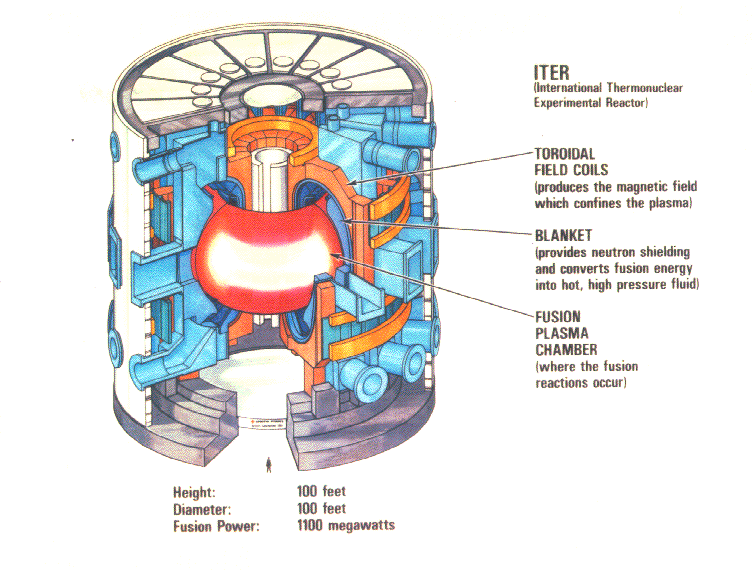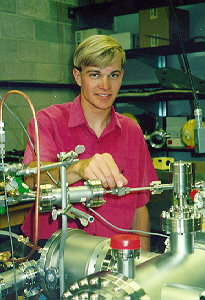My job at UNLV


My job at UNLV

We need a source of atomic hydrogen in this research because laboratory hydrogen is molecular, or is made up of molecules consisting of two atoms of hydrogen tightly bound to each other. This hydrogen source was built for us by Harvard University, and uses an amplified radio frequency of about 6 Hz to break the molecules of hydrogen appart and thus make atomic hydrogen.
Since we only want to study the interactions between one type of ion and molecular hydrogen, we must have a way of generating ions easily. This is accomplished by shooting two laser beams perpendicular to each other through the center of the trap, and hitting a disk of metal containing the desired ions (If we want to study iron ions the target is made of iron etc.). When each laser hits its respective target, ions are given off and are reflected back along the path of the incoming laser beam. Thus the ions colide at the center of the trap and lose nearly all of their energy. This causes the ions to be nearly stationary, and gives us enough time to turn on the RF field and trap them.
Next we must have an ion trap, so that we can hold the ions in one place and study them in the laboratory. The trap itself is a mesh cylinder called the ring electrode, with a circular mesh cap on each end. When we want to trap ions, a radio frequency is applied to the cylinder, and DC bias voltage is applied to the endcaps. Once the voltage rises to about 400V, the ions are trapped. Later when we want to dump the ions, the RF field is turned off, and the endcaps are biased at opposite charges.
The laser firing, ion trapping, and ion dumping are all coordinated by electronic devices, most of which Patrick and I have built or will have built before the summer is over. These devices simply send a pulse to the laser telling it to fire, then after a period of time (determined by the electronics), a pulse is sent to the RF generator telling it to trap the ions. Then after a set period of time (also determined by our electronics) a pulse is sent to the RF generator telling it to shut off, and another pulse sent simultaneously charges one endcap to +500V and the other to -500V thus extracting the ions from the trap and directing them toward our detectors to be analyzed.
Electronics are used in every aspect of this research, most of which are or will have been built by students at UNLV. One electronics box is used to protect the UHV chamber from damage in the event of an equipment failure. If the power fails for more than 20 seconds, if the laser cooling water temperature rises above a predetermined temperature, if the laser cooling water stops flowing, or if the vacuum pressure rises above a safe operating pressure for the turbo pump, the turbo pumps are shut off, and the system is valved off so that the problem can be determined and solved during the next working day with minimal damage to equipment. This device allows us to operated the system overnight unattended, Since the system takes a few days to pump down to operating pressure. Another device monitors the laser cooling water temperature, and switches to tap water as a cooling source if the laser cooling water temperature rises above a predeterimed temperature. A third device cuts the RF signal between the RF generator and the RF amplifier. While at the same time if cuts the RF signal between the RF amplifier and the ion trap. This cuts the RF signal from approximately 400 volts to 0 volts in a matter of nano seconds so that the ions don't scatter in all directions when the RF signal is turned off. This allows us to direct all of the ions toward our instruments at will. A fourth device takes in a ten Hz signal and uses a series of counters controlled by thumbnail switches and creates a laser firing signal and an ion dump signal. The thumbnail switches allow you to choose the delay between creating the ions and dumping them from the trap.
All of the instruments discussed previously with the exception of the electronics and the laser must be placed under an Ultra High Vacuum. This is necessary so that only the ion of interest and atomic hydrogen are present during the experiment. A differential pumping scheme (In differential pumping, a series of chambers are set up so that one end has a higher pressure than the other.)was selected becuase the hydrogen source can handle a pressure no lower than 1E-3 torr(1 torr = 1 millimeter of mercury, and atmospheric pressure is 760 torr), but the ion trap must have a pressure as low as 1E-10 torr. To achieve the low pressure required by the ion trap, the vacuum chamber and all components must must be extremely clean. To make sure that this is the case, we clean all components in a three step cleaning process, using trichloroethylene methanol and ascetone in an ultrasonic washer. After they have been cleaned they are minimally handled and only then with lint free gloves. To further avoid contamination problems we are using a type of vacuum pump called a Turbo Molecular Pump, which is basically a jet engine that runs on electricity. This pump has no lubricating greases or but instead uses ceramic ball bearings. The turbines in this pump turn at 50,000 rpm and are able to remove a single hydrogen atom at a time once the pressure drops and the atoms become scarce. These pumps are very expensive, but they are also very clean and cleanliness is a major requirement in this research.
After a few weeks of getting accustomed to our surroundings, we were turned loose on the apparatus. We hooked up the laser cooling water and got the temperature control unit working. Then we built the fail safe device(described earlier) that had been started last summer. At first we tried to salvage it, but then decided it would be much easier to start all over. Next we made ourselves familiar with the leak detector, and leak tested the gas handling system. The gas handling system is a system of copper tubing that delivers molecutlar hydrogen to the hydrogen source where it is dessociated. We later found out that the palladium valve required a working pressure of 2000 psi. so a new regulator was ordered and the copper tubing will soon be changed out for stainless steel.
While we were becoming familiar with the leak detector, we were also learning how to use the lathe and other large machinery in the machine shop so that we could manufacture our own ion trap. At this point our advisor left us for about 3 weeks because of a family emergency. During this time, we designed two circuit boards on the computer so that we could print our own professional looking circit board. This took much longer than expected because the layouts became very complicated very quickly, and because we had several bugs in our breadboard version. While Dr. Kwong was gone, I also began the process of manufacturing the ion trap, and in the process I was able to contribute to the design of the trap by making it much simpler to construct.
At this point all the pieces of the trap are manufactured except for the ring electrode. We have decided to shift our efforts to hooking up the hydrogen so that we can accually turn on the apparatus before the program ends.
I learned several things this summer, asside from the material mentioned earlier. One thing that I realized early on was that I didn't know as much about electronics as I thought I did, and I plan on taking an electronics course next fall to correct this problem. During this experience I was also reassured that research is a long slow process with many frustrating days and only a few moments of glory. I had already experienced this process at my university, but spending ten seeks doing research has driven the point home.

